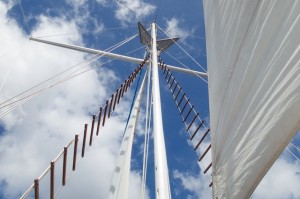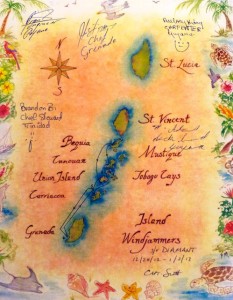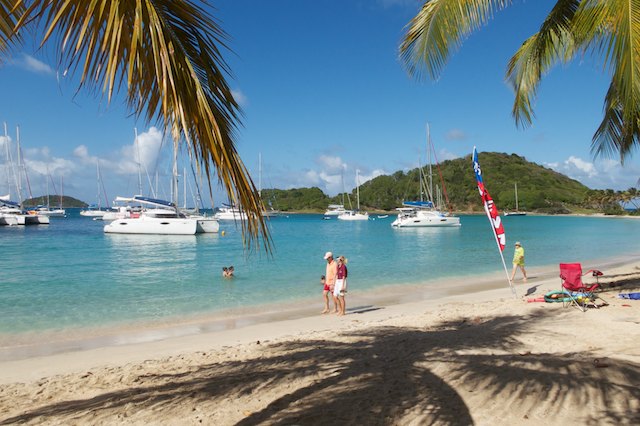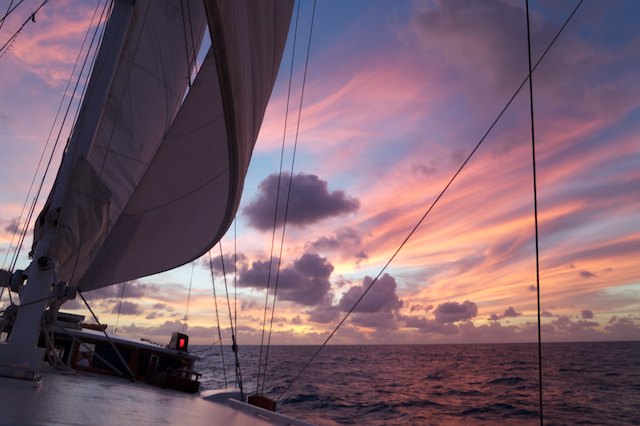Dateline: December 28
When someone of the American persuasion tells you that they are taking a cruise, what they typically mean is that they are getting on board some gigantic facsimile of the Love Boat. My earnest suspicions are that most Americans like to take cruises because a) they are a bit lazy; they want to go to distant locations without all the hassles of traveling, b) the food, and c) the food. Which, let’s all be honest, is grotesquely plentiful on cruise ships. The really big boats have that going for them, and if you don’t care all that much about the quality of the food, you’ll be (you’ll pardon the expression) in pig heaven. They also have features like pools and casinos and theaters and nightclubs and spas and 24 hour a day bars, just in case you hanker for a little drinkie at 5 a.m.
This is decidedly NOT how we cruised the Caribbean. An alternative way to go, (and our way, it turned out), is to sail the Caribbean aboard one of the teeny-tiny sailboats, (ours was a scant 103 linear feet in length) sometimes called a “tall ship”. “Tall ship” because these boats are REAL sailboats and they actually have big tall masts and genuine sails that unfurl quite majestically as you skim over the azure seas at whatever the velocity of the current wind dictates, in case you have a secret inner Kennedy, which I do. Now THAT is sailing! (Contrasted with the floating cities of the “royal” variety which I think of as sort of floating Hometown Buffets writ large.)

Confession: a small, misanthropic part of me always wanted to buck the over-rated, so called, “normal” trend, skip all expected conventions, and live on board a sailboat year round. Meet “Ben”, the young skipper of the Diamant, our noble sailing vessel and home for one glorious week. (Note: Ben is not the skipper’s real name, but as he is a ringer for Ben Affleck, he was and will forever be “Ben” to me. I don’t even remember his real name.) When he is not commanding the helm of the Diamant, Ben and his young bride live that alternate fantasy reality to my super standard, play by the rules, white picket fence, mortgage, mini van, soccer mom history, on board their own, similarly sized sailboat. Ben and Mrs. Ben have a baby, too. While most people (6 cabins = 12 passengers) were occupied with the usual activities afforded by sailing, i.e. lying about the deck in various forms of utter relaxation, I queried the young captain incessantly. “Do you ever feel claustrophobic with such limited space?” “How much does it cost to buy a sailboat like this?” “How do you keep the baby from falling into the sea?” “What do your parents think about your lifestyle?” “How does one go from the University of Michigan, Ann Arbor to the open seas of the West Indies?” And, on and on. I’m sure he was sick of me but he was gracious. And, who knew? Lake Michigan is an excellent training ground for a young, tall-ship skipper.
Do I recommend this kind of cruise? Absolutely! Here’s our itinerary aboard the Island Windjammers’ Diamant:

12/28 – Set sail out of the port in Grenada after a brief introduction to our fellow passengers. On a boat this tiny, traveling with ten total strangers could be just god awful. Thankfully, our worst travelling companions were charmingly “unique”, even entertaining. Only one of the five couples besides us (two of our shipmates were single guys), had zero sailing experience. Every body else had a number of trips like this one under the belt, and one couple were sailboat owners themselves who had only recently sailed all the way to Australia from San Diego, just the two of them. We had only enough time to get an orientation and the standard safety lecture before heading out to the general vicinity of Carriacou. Carriacou is the largest island of the Grenadines but tiny at only about 13 square miles. Population estimates are around 4500. Tourism literature tells you that the primary industry of Carriacou is “boat building, fishing and seafaring” but nobody we found could tell us exactly what “seafaring” means. A few people snickered when I asked, so it might be illegal. First lesson: Contrary to intuition, Crocs are not the preferred foot apparel on a sailing vessel. (Slippery little mo-fos will be the death of you on a wet surface.) Second lesson: Apply the patch for seasickness at least several hours prior to embarkation. (You will not make this mistake twice.)
12/29 Salt Whistle Bay near Carriacou to Tobago Cays: There are four hands on board in addition to the chef, plus the captain, meaning that the service personnel to passenger ratio is one to two. Somehow this ratio translates into a general feeling of pampering and, if not splendor, at least comfort. The food is quite good although how a single person can consistently pump meals for twelve people out of a kitchen the size of a phone booth is nothing short of a miracle. We ate indoors for breakfast always and also for lunch if the crew didn’t bring lunch over to whatever island we were snorkeling on by launch in the form of a picnic. Dinners were served al fresco up on the aft deck. A cooler stocked with all manner of beverages, available 24/7 = happy sailors.
12/30 Tobago Cays are part of the Grenadines, an archipelago of five tiny islands half way between Grenada and St. Vincent. The islands are uninhabited and the surrounding sea is designated as a National Marine Park. About 20% of the 50,000 cruise ship visitors that make it to the Grenadines also get to the Cays. Approximately 3,000 yachts shelter there overnight each year and then you’ve got your day trippers from nearby resorts. This area is highly trafficked, kind of like a combination of Sea World and the Indianapolis 500 for boats.
12/31 New Years eve on Bequia. First we went ashore for an island tour (including the Old Hegg Turtle Sanctuary) and a delicious lobster dinner (see Coco’s in the trip notes) to celebrate the new year. Then back to our home on the seas to watch the fireworks being shot off the beach in Bequia town and also from the decks of a few of our neighboring moored yachts. This was a unique way to ring in the new year.
1/1 Doubling back and heading to Grenada we stopped at a tiny Sandy Island known for excellent snorkeling, and it was. There was not a shade tree to be found however so almost everyone got a little too much Vitamin D, if you know what I mean.
1/2 Back to Grenada to sleep on board in the port one final night before disembarkation.
So, what’s the take-away? The Island Windjammers got it goin’ on. They run a tight ship, literally, so there’s nothing to complain about. Good personnel, a great overall experience in one of the most beautiful locations in the tropics. In fact, look up island paradise in the dictionary and there’s probably a picture of the beach at Chatham Bay on Union Island. The resort there was not yet up and running, but it will be shortly and THAT would be a spectacular location for a honeymoon, although $$$$$. (We paid US$20.00 for a bowl of conch chowder, albeit the best damn conch chowder in the history of conch chowders worldwide.)
In sum, these kinds of cruises are for fit people, (not Diana Nyad fit but you do have to be able to climb in and out of the launch which is how you get over to the islands). I surmise that the majority of people who take this particular kind of cruise are those who are interested in prolonged snorkeling ventures. Cultural visits are at a minimum and 90% of your meals are on board, so you won’t be frequenting many island dining establishments. (The Grenadines are really tiny so you probably aren’t missing much in those categories anyway.) But, if you ever wanted to know what it feels like to be Jackie O aboard her yacht for a week, this is definitely the way to sample that without having to sell your first born.
Next desto, Barbados, where it is rumored that Jackie O spent some quality time for reals back in the day.





